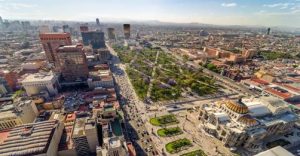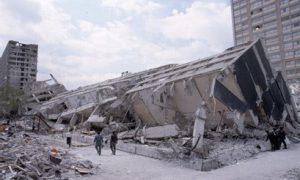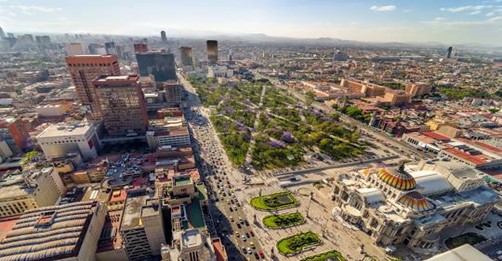Mexico
Mexico
Mexico, nestled in southern North America, ranks as the third-largest in Latin America, trailing only Brazil and Argentina. This vibrant nation bears the hallmarks of stark socioeconomic disparities, with a privileged class of landowners and investors on one end, and a modest middle class bridging the rural-urban divide on the other. Mexico, a developing nation, stands as a formidable player in Latin America, boasting a robust industrial sector, abundant mineral wealth, a thriving service industry, and the world’s largest Spanish-speaking population, surpassing even Spain and Colombia combined. As the “Estados Unidos Mexicanos”officially denotes, Mexico encompasses 31 states, each teeming with unique cultural and geographical richness, along with the Federal District.

Over half of Mexico’s population thrives in the central regions, while the northern deserts and lush southern landscapes remain sparsely inhabited. A significant urban shift sees about 80% of Mexicans residing in cities, with Mexico City standing as one of the world’s most densely populated urban centers. Mexico’s history unfolds in cycles of economic prosperity, offering hope and progress, yet often overshadowed by setbacks that impact the living standards of the middle and lower strata. Despite forging robust alliances with the United States and Canada through NAFTA, Mexico grapples with persistent economic challenges.
In Mexico, a tale of two worlds unfolds: bustling urban challenges sharply contrast with the timeless rural life found in secluded regions. States like Oaxaca and Chiapas host indigenous communities preserving ancestral traditions. The vestiges of grand pre-Columbian civilizations, like the awe-inspiring Maya pyramids at Teotihuacan, cowardly, Itza, and Tulum, offer a striking counterpoint to the colonial splendor of Taxco and Querétaro. These colonial cities, in turn, seem like historical gems when compared to the sprawling modernity of Mexico City. The capital, an ever-evolving metropolis rising upon layers of past civilizations, mirrors the vast spectrum of Mexico’s ongoing social, economic, and cultural challenges. As the eminent Mexican poet and intellectual, Octavio Paz, eloquently noted,
What Causes Earthquakes in Mexico City?
Mexico sits on a subduction zone, where the Cocos Oceanic Plate plunges beneath the North American continental plate. This interaction generates powerful earthquakes due to friction. Adding to the impact, Mexico City’s foundation rests on soft soil, exacerbating the seismic effects from this tectonic dance.

- Q: Where is Mexico located, and what countries does it share borders with?
A: Mexico is located in North America and shares borders with the United States to the north, Belize and Guatemala to the south, and is bounded by the Pacific Ocean and the Gulf of Mexico.
- Q: What is the capital city of Mexico, and what are some of its significant landmarks?
A: The capital city of Mexico is Mexico City. Significant landmarks include the Zocalo, the Metropolitan Cathedral, and the National Palace.
- Q: What is the official language of Mexico?
A: The official language of Mexico is Spanish.
- Q: What is the currency used in Mexico?
A: The currency used in Mexico is the Mexican Peso (MXN).
- Q: What are some of the famous tourist destinations in Mexico?
A: Mexico is known for its diverse tourist destinations, including Cancun and the Riviera Maya, Mexico City, Chichen Itza, Tulum, and the beaches of Playa del Carmen.
- Q: What is the significance of the Day of the Dead (Día de los Muertos) in Mexican culture?
A: The Day of the Dead is a Mexican holiday honoring deceased loved ones. Families gather to celebrate and remember the lives of those who have passed away.
- Q: What is the traditional Mexican cuisine known for, and what are some popular dishes?
A: Mexican cuisine is known for its bold flavors and diverse ingredients. Popular dishes include tacos, enchiladas, guacamole, and tamales.
- Q: Can you name some ancient civilizations that thrived in Mexico, and what archaeological sites represent their legacy?
A: Mexico has a rich history with civilizations like the Aztecs, Maya, and Olmecs. Archaeological sites include Teotihuacan, Chichen Itza, and Palenque.
- Q: What is the significance of the Aztec capital city of Tenochtitlan, and where was it located?
A: Tenochtitlan was the capital of the Aztec Empire, situated on an island in the middle of Lake Texcoco. It is now the site of Mexico City.
- Q: How does Mexico celebrate its Independence Day, and when is it observed?
A: Mexico celebrates Independence Day on September 16th. Festivities include the “Grito de Dolores,” a reenactment of Miguel Hidalgo’s call for independence.
- Q: What are some of Mexico’s natural wonders, including geographical features and biodiversity?
A: Mexico boasts diverse natural wonders, such as the Copper Canyon, the Yucatan Cenotes, and a rich variety of flora and fauna in places like the Monarch Butterfly Biosphere Reserve.
- Q: How does Mexico contribute to global culture, particularly in the fields of art, music, and literature?
A: Mexico has made significant contributions to global culture, with renowned artists like Frida Kahlo, a vibrant music scene encompassing mariachi and traditional styles, and influential literature, including the works of Octavio Paz.
- Q: What is the current economic status of Mexico, and what are its main industries and exports?
A: Mexico has a diverse economy with industries including manufacturing, agriculture, and services. Key exports include automobiles, electronics, and petroleum.
- Q: How is Mexico addressing environmental challenges and promoting sustainability initiatives?
A: Mexico is actively working on environmental issues, including conservation efforts, renewable energy projects, and initiatives to address pollution and deforestation.
- Q: Can you describe the traditional clothing and cultural attire associated with different regions of Mexico?
A: Traditional clothing varies across regions in Mexico. For example, the charro suit is associated with Jalisco, while embroidered dresses and sombreros are typical in regions like Oaxaca.

